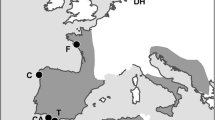Summary
The fate of individual plants of Helianthus annuus was monitored in populations sown at a density of 650 seeds m-2. Ninety six percent of the seeds germinated but only fifty two percent of the seedlings survived to the end of the experiment due to self-thinning. Whilst the seedlings emerged over only four days the cotyledons then took up to eight days to emerge from the seed case and open fully. The survival of individuals depended primarily on cotyledon-opening time but plants which occupied very small areas (<900 mm2) at germination were also less likely to survice. The increased likelihood of mortality amongst the late germinating individuals was probably as a result of shade from older, larger neighbours. It is suggested that one-sided interference for light during self-thinning will increase the importance of early establishment relative to neighbour effects in determining the survival of plants except at very high levels of crowding. The complex of environmental and genetic factors acting to maximise the growth rate of the very young seedling relative to its neighbours will clearly play an important part in determining the position of a plant in the size hierarchy of a population.
Similar content being viewed by others
References
Aikman DP, Watkinson AR (1980) A model for growth and self-thinning in even-aged monocultures of plants. Ann Bot 45:419–427
Black JN (1958) Competition between plants of different initial seed sizes in swards of subterranean clover (Trifolium subterraneum L.) with particular reference to leaf area and the plant microclimate. Aust J Agric Res 9:299–318
Black JN, Wilkinson GN (1963) The role of time of emergence in determining the growth of individual plants in swards of subterranean clover (Trifolium subterraneum L.). Aust J Agric Res 14:628–638
Gottlieb LD (1977) Genotypic similarity of large and small individuals in a natural population of the annual plant Stephanomeria exigua ssp. coronaria (Compositae). J Ecol 65:127–134
Harper JL (1977) Population Biology of Plants. Academic Press, London
Hiroi T, Monsi M (1966) Dry-matter economy of Helianthus annuus communities grown at varying densities and light intensities. J Fac Sci Univ of Tokyo 9:241–285
Koyama H, Kira T (1956) Intraspecific competition among higher plants. VIII. Frequency distribution of individual plant weight as affected by the interaction between plants. J Inst Polytech Osaka Cy Univ 7:73–84
Levin DA, Wilson JB (1978) The genetic implications of ecological adaptations in plants. In: Freysen AHJ, Woldendorp JW (eds), Structure and Functioning of Plant Populations. North-Holland Pub Co p. 75–100
Liddle MJ, Budd CSJ, Hutchings MJ (1982) Population dynamics and neighbourhood effects in establishing swards of Festuca rubra L.
Lonsdale WM, Watkinson AR (1983) Plant geometry and self-thinning J Ecol (in press)
Mack R, Harper JL (1977) Interference in dune annuals: spatial pattern and neighbourhood effects. J Ecol 65:345–363
Mead R (1966) A relationship between individual plant spacing and yield. Ann Bot 30:301–309
Obeid M, Machin D, Harper JL (1967) Influence of density on plant to plant variations in Fibre Flax, Linum usitatissimum. Crop Sci 7:471–473
Rabinowitz D (1978) Bimodal distributions of seedling weight in relation to density of Festuca paradoxa Desv Nature (Lond) 277:297–298
Rhynsburger D (1973) Analytical delineation of Thiessian polygons. Geog Analysis 5:133–144
Ross MA (1968) The establishment of seedlings and the development of patterns in grassland. Ph D Thesis, University of Wales
Ross MA, Harper JL (1972) Occupation of biological space during seedling establishment. J Ecol 60:77–88
Soetono, Puckridge DW (1982) The effect of density and plant arrangement on the performance of individual plants in barley and wheat crops. Aust J Agric Res 33:171–177
Waller DM (1981) Neighbourhood competition in several violet populations. Oecologia 51:116–122
Watkinson AR (1981) Interference in pure and mixed populations of Agrostemma githago. J Appl Ecol 18:967–976
White J, Harper JL (1970) Correlated changes in plant size and number in plant populations. J Ecol 58:467–485
Yoda K, Kira T, Ogawa H, Hozumi K (1963) Self-thinning in over-crowded pure stands under cultivated and natural conditions. J Biol Osaka Cy Univ 14:107–129
Author information
Authors and Affiliations
Rights and permissions
About this article
Cite this article
Watkinson, A.R., Lonsdale, W.M. & Firbank, L.G. A neighbourhood approach to self-thinning. Oecologia 56, 381–384 (1983). https://doi.org/10.1007/BF00379716
Received:
Issue Date:
DOI: https://doi.org/10.1007/BF00379716



